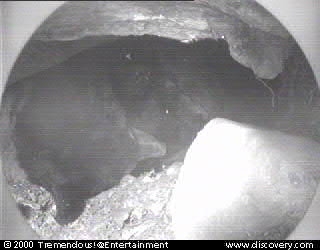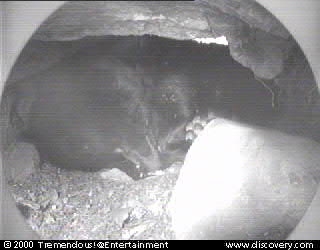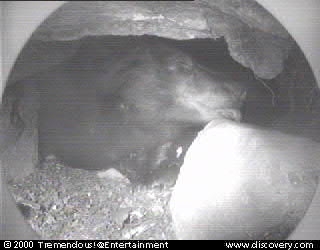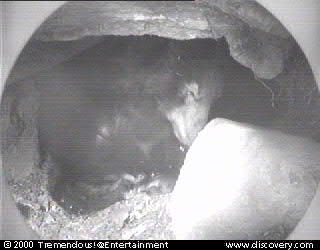1999 Fall - Hibernation study conducted
Black bears are masters of winter survival. Their winter survival rate is over 99 percent, impressive by any standard. For many other northern species, including primitive humans, winter often means food shortage and even starvation. Native Americans believed bears to be smarter than people because bears know how to survive winter food scarcity.
Black bear adaptations to obtain and digest food are all specialized toward exploitation of summer foods. Their body form, claws, teeth, dentition, stomach structure, and digestive tract are all geared to obtain small, easily digestible foods like berries, nuts, succulent leaves, colonial insects, and newborn animals-foods available mostly during the warm growing season. They lack the ability to digest winter's tough vegetation or to chase down adult prey animals in the snow. Part of their adaptation to the environment is the ability to hibernate. Hibernation limits their range to northern areas with strong seasons. Black bear range extends only as far south as the mountains of northern Mexico. Further south, they would compete with non-hibernating animals better adapted to a non-seasonal environment.
Once considered not to be true hibernators because they maintain high body temperatures in winter, black bears are now recognized as highly efficient hibernators-some say super hibernators. They sleep for months without eating, drinking, urinating, or defecating. Hibernators with lower body temperature, such as chipmunks, woodchucks, and ground squirrels, cannot do this. These other mammals must awaken every few days, raise their temperatures to over 94 degrees Fahrenheit, move around in their burrows, and urinate. Some of them must also eat and defecate during periodic arousals. Black bears develop far more insulated pelts and have lower surface-to-mass ratios than these smaller hibernators. As a result, a bear's body heat is lost very slowly. Although its metabolic rate is reduced by half, it still maintains a hibernating temperature above 88 degrees-within 12 degrees of its active summer temperature.
This high resting temperature means, among other things, hibernating black bears can react more quickly to danger than other hibernating animals whose body temperatures may be less than 40 degrees. New knowledge of hibernation processes has led biologists to redefine mammalian hibernation simply as specialized, seasonal reduction of metabolism in response to the concurrent pressures of food unavailability and low environmental temperatures.
I have studied black bear behavior and ecology in northeastern Minnesota since 1969. In this time I observed bears that went as long as seven months without eating-from mid-September until mid-April. The two radio-collared bears I study in cooperation with the North American Bear Center-Whiteheart and Blackheart-stopped eating this Fall about September 20. By September 24, Whiteheart had dug her hibernation burrow.
Blackheart chose a hibernation site on the ground surface sheltered by a fallen balsam fir crown. Both bears spent time in late September and October raking bedding into their dens. By early November, one could walk right up to these hibernation sites. Each bear did little more than open its eyes in response to human presence.
To remain in good physical condition for months without eating requires change in a bear's body chemistry. Some of the physiological changes in healthy hibernating bears would be a real problem for people. How hibernating bears remain healthy in winter and how their physiological adaptations might be useful in human medicine are subjects of study at some of North America's leading medical research centers. For example, bears living off their accumulated body fat have hibernating cholesterol levels more than twice summer levels and more than twice as high as the normal cholesterol levels of most humans. Yet bears exhibit no hardening of the arteries or formation of cholesterol gallstones. Medical studies reveal hibernating bears produce a bile juice, ursodeoxycholic acid that may help them avoid problems with gallstones. When this acid is given to people it dissolves gallstones and eliminates the need for surgery. Hibernating black bears also exhibit reduced kidney function. They do not urinate for months but still do not poison their bodies with waste products such as urea. Urea is somehow broken down and its nitrogen is reused to build protein. The ability to build protein while fasting allows black bears to maintain their muscle and organ tissue throughout the winter. They only use up fat. Evidence is accumulating that hormone-like substances control physiological changes in hibernating black bears. These substances also produce hibernation-like effects when injected into other species-both other hibernators and non-hibernators, suggesting potential human medical applications.
Hibernation for the black bear, as for other mammals, is primarily a mechanism to conserve energy through seasons of no food or water. The process, however, does not work in summer. If there is an insufficient food supply in summer months, bears can lose weight and starve, much as we would. Female bears that gain sufficient weight in summer are the ones that produce cubs. In northeastern Minnesota, females that weigh over 176 pounds in Fall produce cubs in January. Those that weigh 148 to 175 pounds in Fall may or may not produce cubs, and those weighing less than 148 pounds produce no cubs. Whiteheart and Blackheart both appeared to be in the 170 to 200 pound range in fall, and we hope they will produce cubs.
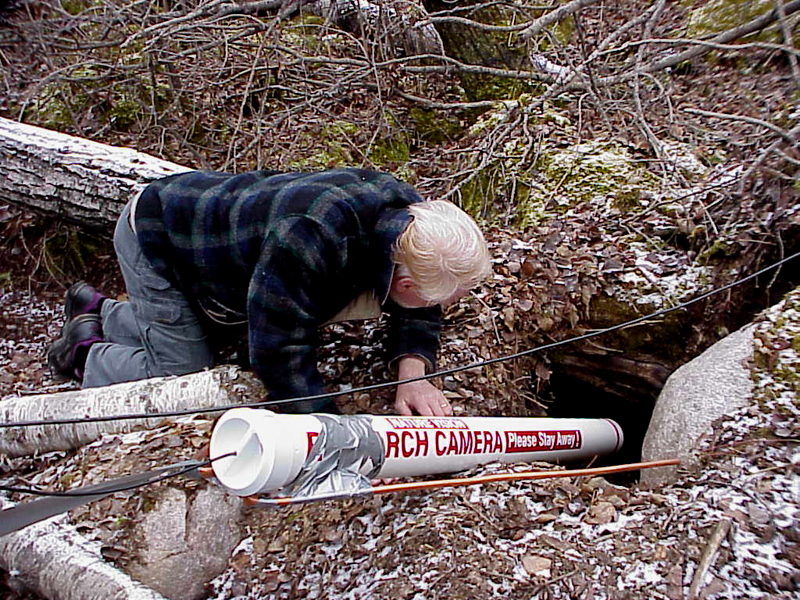 Advances in technology have made it possible to learn more about the
behavior of bears in dens. Nature-Vision company has designed a special
infrared video camera built to perform in harsh environments. We intend
to place one of these special cameras in Whiteheart's den and
hopefully, as she produces and cares for her cubs, we can monitor her
behavior all winter. Discovery Channel Internet site is funding this
part of our hibernation research project. They plan to have
Whiteheart's televised image on their web site (www.discovery.com) this winter.
Advances in technology have made it possible to learn more about the
behavior of bears in dens. Nature-Vision company has designed a special
infrared video camera built to perform in harsh environments. We intend
to place one of these special cameras in Whiteheart's den and
hopefully, as she produces and cares for her cubs, we can monitor her
behavior all winter. Discovery Channel Internet site is funding this
part of our hibernation research project. They plan to have
Whiteheart's televised image on their web site (www.discovery.com) this winter.
The North American Bear Center will have a link to the Discovery website so visitors to the Bear Center website can go see Whiteheart on the Discovery website. Whiteheart's image will be updated every thirty seconds, allowing us (as well as thousands of website visitors) to observe the extent and nature of her movements in hibernation. Hopefully, Whiteheart will give birth and her cubs will be visible at least some of the time. We will monitor her movements in the den and, thanks to the North American Bear Center and the Discovery Channel, we will learn more about the black bear's hibernation behavior.
The following pictures of Whiteheart in her den were downloaded in quick succession on February 3, 2000:
